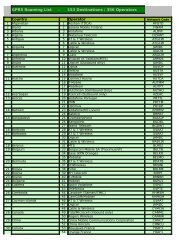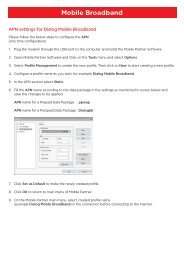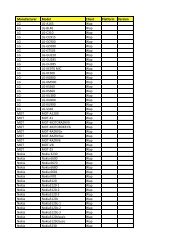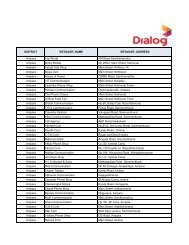Annual Report 2012 - Dialog
Annual Report 2012 - Dialog
Annual Report 2012 - Dialog
Create successful ePaper yourself
Turn your PDF publications into a flip-book with our unique Google optimized e-Paper software.
70 l <strong>Dialog</strong> Axiata PLC l <strong>Annual</strong> <strong>Report</strong> <strong>2012</strong><br />
Notes to the Financial Statements<br />
2 Summary of significant accounting policies contd.<br />
2.13 Trade and other payables contd.<br />
(e) Share-based compensation contd.<br />
Non-market vesting conditions are included in the assumptions about the number of options that are expected to vest.<br />
At the date of statement of financial position, the Company and the Group revise its estimates of the number of share<br />
options that are expected to vest. It recognises the impact of the revision of original estimates, if any, in the statement of<br />
comprehensive income, with a corresponding adjustment to equity.<br />
The proceeds received net of any directly attributable transaction costs are credited to share capital (nominal value) and<br />
share premium when the options are exercised.<br />
2.17 Deferred revenue<br />
Deferred revenue comprises of, the unutilised balance of call time, telecast time and downloadable quota in respect of<br />
prepaid cards and services sold to customers. Such revenue amounts are recognised as revenue upon subsequant<br />
utilisation of call time, telecast time and downloadable quota by the customer or when the credit expires.<br />
2.18 Subscriber acquisition costs<br />
Subscriber acquisition costs comprise handset and other subsidies offered under usage contracts in excess of one (1)<br />
year. Subscriber acquisition costs are amortised over the contract period and reviewed annually for impairment. Other<br />
subscriber acquisition costs under usage contracts less than one (1) year are recognised as an expense in the statement of<br />
comprehensive income as incurred.<br />
2.19 Provisions<br />
Provisions are recognised when the Company and the Group have a present legal or constructive obligation as a result of<br />
past events when it is more probable that an outflow of resources will be required to settle the obligation and when a reliable<br />
estimate of the amount can be made. Provisions are not recognised for future operating losses.<br />
Where there are number of similar obligations, the likelihood that an outflow will be required in settlement is determined by<br />
considering the class of obligations as a whole. A provision is recognised even if the likelihood of an outflow with respect to<br />
any one item included in the same class of obligations may be small.<br />
Provisions for asset retirement obligations are measured at the present value of the expenditures expected to be required to<br />
settle the obligation using a pre-tax rate that reflects current market assessments of the time value of money and the risks<br />
specific to the obligation. The increase in the provision due to passage of time is recognised as finance cost.<br />
2.20 Contingent liabilities and contingent assets<br />
The Company and the Group do not recognise a contingent liability but disclose its existence in the financial statements. A<br />
contingent liability is a possible obligation that arises from past events whose existence will be confirmed by uncertain future<br />
events beyond the control of the Company and the Group or a present obligation that is not recognised because it is not<br />
probable that an outflow of resources will be required to settle the obligation. A contingent liability also arises in the extremely<br />
rare circumstance where there is a liability that cannot be recognised because it cannot be measured reliably.<br />
A contingent asset is a possible asset that arises from past events whose existence will be confirmed by uncertain future<br />
events beyond the control of the Company and the Group. The Company and the Group do not recognise a contingent<br />
asset but discloses its existence where inflows of economic benefits are probable, but not virtually certain.<br />
In the acquisition of subsidiaries by the Group under a business combination, the contingent liabilities assumed are<br />
measured initially at their fair values at the acquisition date, irrespective of the extent of any minority interest.



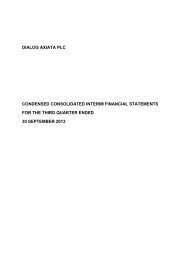
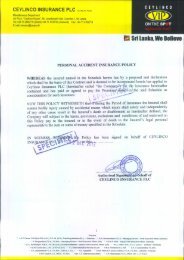
![nrypq;Nfh ,d;#ud;;]; nfhk;gdp ypkplw - Dialog](https://img.yumpu.com/15429071/1/190x245/nrypqnfh-dud-nfhkgdp-ypkplw-dialog.jpg?quality=85)
